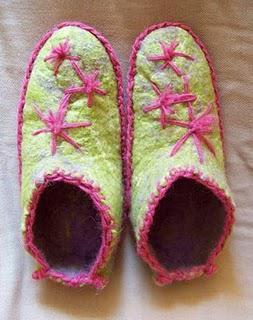
When Evi, creator of the http://dimiourgw.ning.com/ social network, asked me to write a post about felting, I honestly hadn’t realized how much there is to say in order to describe this technique or, to be more precise, the two basic techniques of processing unspun wool roving to create felt. In short, it is one thing to actually do it or to have someone show you how it’s done, and another to describe in words the entire process. That’s what I realized, as the days went by and I started working on the text in my mind.
I considered the alternative of making a photo tutorial, but I rejected it almost immediately. I don’t believe that a process with constant movement, such as felting, can be explained thoroughly through photographs. The best solution would be for me to make a relevant video. Unfortunately I do not have the equipment for such a project. However, I will try to offer you the best possible description of these two techniques, needle felting (using barbed needles) and wet felting (using soapy hot water). First of all, each one is suitable for different things. For example, with both techniques we can create pins and brooches. With different textures, of course. But if we want to make bags, mobile cases and anything that requires durability and stability, wet felting is preferable.
In needle felting we use special barbed felting needles, usually three-sided, with very sharp tips and small barbs. The most common sizes or “gauges” one can find on the market are 36, 38 and 40. I have used all three of them, but I usually use 38 gauge, since I have noticed only minor differences between them. 40 gauge is more suitable for finer surface work or finer wool, while number 36 is suitable for coarser fibers and 38 for medium grade wool.
As I have already mentioned, felting needles have small barbs. Those barbs help mix the wool fibers, locking them together into a solid mass. And they also have extremely sharp tips! Ouch! I just remembered how many times I have been pricked and it hurts all over again! LOL! Okay, it’s not that much of a tragedy, but it IS painful and it heals slowly. No comparison with conventional needles! Therefore, CAUTION-CAUTION!
As a working base we use a special kind of sponge. You can always use a common large bath sponge, but it will sag quickly from the pressure of the needle and it will start to pluck. On the market you can find thick, dense, spongy foams or foam pads. Also, you can find brush-like mats as an alternative to using a foam pad (I haven’t used something like that, so I don’t have an opinion on such products), special holders for one needle, which I also haven’t used yet, and different kinds of tools (punches) that hold multiple felting needles for faster felting on larger surfaces. I do have such a punch, a simple, wooden one for 4 felting needles, but I don’t use it very often, since I rarely work on large surfaces. It is, however, very convenient and certainly faster than working with a single needle.
The needle should be used as upright as possible on the foam pad, not at an angle. This way it will break… later rather than sooner! Because one thing is for certain, sooner or later the tip will break off! Unfortunately,felting needles break very easily, since the metal they are made of doesn’t bend much! So, we take some wool roving, as much as we need for what we want to create, we lay it on our foam pad and begin to poke the needle repeatedly up and down into it, with rapid movements in a random pattern, until the fibers have compressed and we achieve the desired effect. I think newbies would be better off using a sheet of industrial feltas a basis. This isn’t absolutely necessary, but I think it's easier that way.
I found a short video on the net that will give you a good idea of how needle felting is performed. I think it will be very helpful. So take a look:
http://www.youtube.com/watch?v=PTBirUlvPNo&feature=fvst
Wet felting is completely different. And I discovered a very enlightening relevant video on the net:
http://www.youtube.com/watch?v=3FK1l7Y6ADc
Here we go then! We need: wool roving, hot water (the hotter the better, but it depends on how hot you can bear it), olive soap or dishwashing liquid (if you use dishwashing liquid, pour a very VERY small amount, only a couple of drops, since you don’t want to be… drown in foam!), plastic bubble wrap, tulle and a towel.
We lay the towel and the bubble wrap on a table. The bubble wrap has bumps that will help the wool fibers blend together. The same applies to the tulle. It will keep the wool where we want it and it will help it “bond”. The fiber blender used by Brookelynn Morris in the video isn’t absolutely necessary in my opinion. You can simply pull off some wool and make it a bit puffy with your fingers. And something very important I forgot to mention until now: we never cut felting wool with scissors! Only by hand! We stretch it a little and pull a bit off. In order to create a smooth, fairly thick layer of felt, we need at least 4-5 layers of wool. One horizontal, one vertical, again one horizontal and so on. The more wool the thicker our felt will be. You don’t need layers that consist of a single piece of wool. On the contrary, it is preferable to add small bits of wool on the surface. The fibers will blend easier and better this way. After we lay our wool, we make some soapy water. The water should be hot, as hot as you can bear it. Throw a bit of olive oil soap or a couple of drops of dishwashing liquid in a bowl of hot water and stir very well to dissolve it. Pour the water carefully over the wool. A bit at a time, so as not to remove the wool from its position. Soak it thoroughly and gently begin to rub the tulle onto the bubble wrap. As you do so, the wool fibers start to blend together. Then wrap it all together (bubble wrap, wool, tulle)... and begin to roll! Back and forth, again and again. A few minutes later, carefully open up the roll to see if the wool has been felted. If necessary, pour a bit more hot water. After a while, your felt is almost ready. All you have to do is rinse it out, first in cold, then in hot and then again in cold water. The cold-hot water circle helps bonding the wool even better. Your felt will shrink more and become more dense and solid.
Allow it to dry completely and you have in your hands a piece of handmade felt. Of course, you may use many colors, but be aware of the fact that the final result isn’t 100% controllable. As you rub the wool, it moves by itself, creating various formations on its own, and therefore it’s a bit unpredictable! But personally I love this feature!
Well, so much for now from me. Any questions, queries or comments are always welcome! ;) ?)
P.S. This text was first published in Greek on February 19, 2011 at http://dimiourgw.ning.com/ It is reproduced here translated in English and with minor editing. Special thanks to The Crafts Channel & Corinne Bradd, and MAKE Magazine & Brookelynn Morris for the use of their videos on YouTube.



COMMENTS ( 1 )
posted on 16 May at 07:44
Bravo, Lito! Thank you,very much!